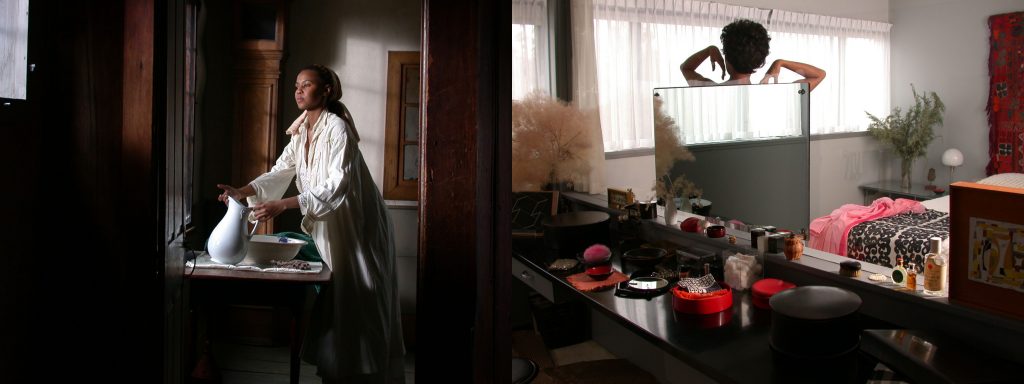Artist:
Lorna Simpson (born 1960 in Brooklyn, USA; lives and works in Brooklyn).
Materials:
Two-channel video installation, 13 min 45 sec and photograph; 27 x 72 inches.
Description:
Consists of a film that depicts the daily routines of two women living in two different centuries and two different worlds. Filmed in two domestic interiors in New England: the Coffin House in Newbury, Massachusetts, occupied by the Coffin Family in 1678, and the single-family residence in Lincoln, Massachusetts, that Walter Gropius built for himself in 1938. The two protagonists are played by Wangechi Mutu. It is accompanied by a photograph of the two buildings.
“Corridor also refers to critical periods in U.S. history, particularly for African Americans—the Civil War and Civil Rights eras. However, the work does so via the daily routine of two black women, both of whom are portrayed by the artist Wangechi Mutu. Although the film is specific in its depiction of the styles, interiors, and technology of the two periods, nothing specific occurs. Simpson invites the viewer to focus on the psychological disposition of the women as they move through the corridors of their respective homes. The work thereby suggests that history comprises individual lives, rather than a series of constructed narratives.
“On the left side of a split screen, Mutu appears as a house servant in 1860—the year of Abraham Lincoln’s presidential election—and on the right, she plays a well-heeled housewife in 1960—the year in which John F. Kennedy became president. Both characters bathe, dress, and clean during the day, and upon nightfall, one woman writes a letter as the other places a telephone call. They do nothing spectacular or stereotypical as they go about their routines in manners similar to each other and perhaps their viewers. Nonetheless, despite their similarities, the women are separated by a century, which is indicated by various instances of formal tension: the split screen and their dissimilar settings as well as the discord from two soundtracks—free jazz and a battle hymn by black composers Albert Ayler and ‘Blind Tom’ Wiggins, respectively—that play simultaneously.
“Moreover, the work recalls dual notions of a corridor. In one sense, it is an area identified by a specific purpose or characteristic. Therefore, the women’s similar domestic routines might suggest that the more things change, the more they stay the same, particularly for gender roles. At the same time, a corridor is also a passageway that opens onto other areas. As each historical moment of change in the U.S. gave way to new opportunities for and further transformation of its citizens, the difference between the characters’ socioeconomic statuses suggests the great progress made by African Americans.
“The concurrence of these divergent interpretations ultimately speaks to the intersectionality of black women. That is, Corridor evokes the overlap, and sometimes contradictory effects, of such aspects of identity as race, class, and gender. Further, like Simpson’s works, such ambiguous experiences cannot be explained by or forced into a simplistic narrative.
—Kanitra Fletcher, “Lorna Simpson: Corridor, 2003,” University of Texas at Austin Landmarks website.


